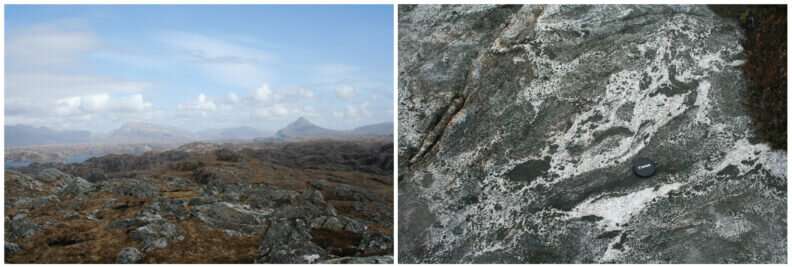Earth's ancient water cycle was key to making continents, study shows

A new Curtin University study has found that water was transported much deeper in the early Earth than previously thought, shedding new light on how the continents were originally formed.
The study, published in Earth and Planetary Science Letters, answers long-standing questions about the early Earth water cycle.
Lead researcher Dr. Michael Hartnady, from the Curtin School of Earth and Planetary Sciences, said how water is stored and transported through Earth's crust influences everything, from where volcanoes and mineral deposits form to where earthquakes occur.
"Although we understand the modern deep-water cycle, we know very little about how it worked when Earth was still a very young planet," Dr. Hartnady said.
"Multiple lines of geological evidence show that water was transported to great depths within Earth all the way back to 3.5 billion years ago, although it is not well understood how exactly it got there."
Researchers used sophisticated modeling to show that primitive high-magnesium volcanic rocks—that erupted onto the ocean floor in the early Earth—would have soaked up much more seawater than more modern lavas.
"This water, which is locked into particular crystals within the rock, would have been released as the rocks were buried and began to 'sweat.' In modern lavas, this sweating happens at a temperature of about 500 degrees Celsius," Dr. Hartnady said.
"Our findings indicate that much of the seawater initially bound within the ancient primitive lavas would have been released at much higher temperatures, greater than 700 degrees Celsius.
"Importantly, this means that the water was transported much deeper into the early Earth than previously thought. Its release would have caused surrounding rocks to melt, ultimately to form the continents."
Dr. Hartnady said this research helped to explain the inner workings of the planet from more than 2.5 billion years ago.
"Interestingly, the oldest parts of the continents, the cratons, also contain some of the largest gold deposits on Earth including the Golden Mile near Kalgoorlie," Dr. Hartnady said.
"These gold deposits required huge volumes of water to form, and we still don't have a good explanation for where it came from. Our new research may help solve these and other questions, perhaps even those related to the origins of life."
More information: Michael I.H. Hartnady et al, Fluid processes in the early Earth and the growth of continents, Earth and Planetary Science Letters (2022). DOI: 10.1016/j.epsl.2022.117695
Journal information: Earth and Planetary Science Letters
Provided by Curtin University




















